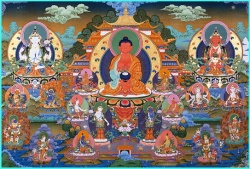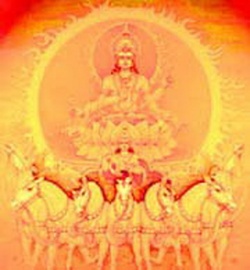Purva Mimamsa
The first major orthodox philosophical system to develop was Purva Mimamsa.
The other one to follow was the Uttar Mimamsa. The orthodox systems accept the authority of the Vedas.
The Sanskrit word 'mimamsa means a ‘revered thought’.
The word is originated from the root ‘man’ which refers to ‘thinking’ or ‘investigating’. The word 'mimamsa' suggests "probing and acquiring knowledge" or "critical review and investigation of the Vedas".
Each of the Vedas is considered to be composed of four parts:
The Samhitas, the Brahmanas, the Aranyakas and the Upanishads. The first two parts are generally focused on the rituals and they form the Karma-kanda portion of the Vedas.
The later two parts form the Jnana-kanda (concerned with knowledge) portion of the Vedas.
Purva-Mimamsa is based on the earlier (Purva = earlier) parts of the Vedas.
Uttar-Mimamsa is based on the later (Uttar = later) parts of the Vedas.
Purva-Mimamsa is also known as Karma Mimamsa since it deals with the Karmic actions of rituals and sacrifices.
Uttar-Mimamsa is also known as Brahman Mimamsa since it is concerned with the knowledge of Reality.
In popular terms, Purva-Mimamsa is known simply as Mimamsa and Uttar-Mimamsa as Vedanta.
Jaimini is credited as the chief proponent of the Mimamsa system. His glorious work is Mimamsa-Sutra written around the end of the 2nd century A.D.
Mimamsa-Sutra is the largest of all the philosophical Sutras. Divided into 12 chapters, it is a collection of nearly 2500 aphorisms which are extremely difficult to comprehend.
Earlier scholars wrote commentaries on Mimamsa-Sutra. Unfortunately they are lost with the passage of time.
The earliest available commentary is Sabarasvamin’s Sabara-bhasya, which is still the authoritative basis of all subsequent works on Mimamsa.
Renowned scholars Kumarila Bhatta and Prabhakara independently wrote their commentaries on Sabara-bhasya. Prabhakara was a student of Kumarila Bhatta.
However, they differed, to some degree, on the interpretation of Sabara-bhasya and wrote separate commentaries. (Mandan Mishra, the erudite scholar, was a follower of Kumarila Bhatta.
He also wrote a commentary, but at a later stage he changed his thinking and became a disciple of Shamkaracharya.)
This system out rightly accept the Vedas as the eternal source of ‘revealed truth.’
Thus though it differs from the earlier four philosophical systems (Vaisheshika, Nyaya, Samkhya, Yoga which neither accept nor reject the authority of the Vedas), a great chunk of Mimamsa philosophy is derived from the Vaisheshika-Nyaya duo.
Mimamsa system attaches a lot of importance to the Verbal testimony which is essentially the Vedic testimony.
Jaimini accepts the ‘Word” or the ‘Shabda’ as the only means of knowledge.
The ‘word’ or the ‘Shabda’ is necessarily the Vedic word, according to Jaimini.
This system strongly contends that the Vedas are not authored by an individual.
Since they are ‘self-revealed’ or ‘apaurusheya’, they manifest their own validity.
The system is a pluralistic realist.
It endorses the reality of the world as well as that of the individual souls.
The soul is accepted as an eternal and infinite substance. Consciousness is an accidental attribute of the soul.
The soul is distinct from the body, the senses and the mind.
Though Kumarila Bhatta and Prabhakara differ on issues like the self, the soul and it attribute.
The earlier mimamsakas do not give much importance to the deities.
Hence they do not endorse God as the creator of the universe. But later mimamsakas show a bent towards theism.
This system has a profound faith in the Vedas. The system supports the law of karma. It believes in the Unseen Power or ‘apurva’. Apart from accepting the heaven and the hell, the system supports the theory of liberation.


